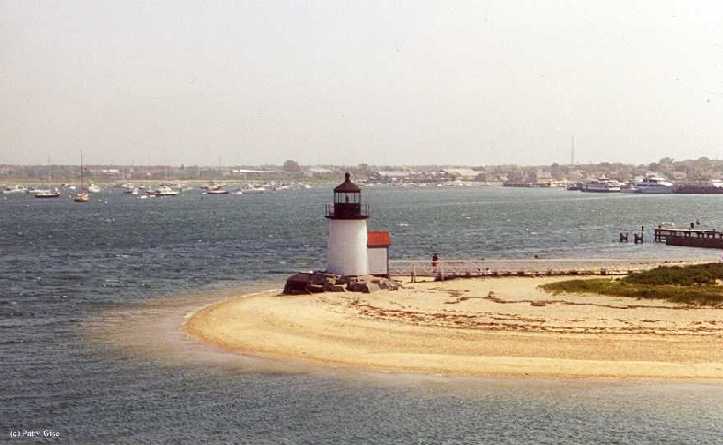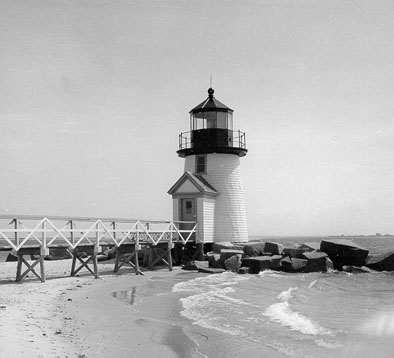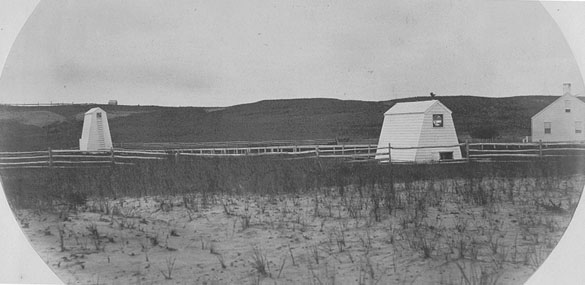Brant Point Lighthouse
Nantucket, Massachusetts - 1901 (1746**)

History of the Brant Point Lighthouse
Posted/Updated by Bryan Penberthy on 2013-08-18.
The island of Nantucket has been occupied since the mid-1650s. It was originally part of the New York colony until 1692 when it was transferred over to the Bay Colony of Massachusetts by an act of parliament. The first town on the island, called Sherburne, was settled on the north shore of the island, but later had its name changed to Nantucket in 1795.
The settlers to the island provided for themselves by farming the land and hunting small game that lived on the island. They eventually took to the water and augmented their diet with the abundant fish that were native to the waters surrounding the island.
 Brant Point Lighthouse (Courtesy USCG)
Brant Point Lighthouse (Courtesy USCG)
Occasionally a whale would drift ashore, and the islanders would harvest it. What they found was that the quantity and quality the oil from the big beast was unmatched. By the early 1700s, the men from the island began to organize voyages to the deeper parts of the ocean in search of the whales. Over the next one-hundred-and-fifty years, the island of Nantucket would be the whaling capital of the world.
Many businesses popped up on the island to support the whaling industry. By the middle 1700s, new larger whaling ships were being constructed that could harvest the whale out at sea. More and more vessels began calling the island home.
With the increased harbor traffic, mariners and merchants voted to erect a lighthouse during a town meeting that took place on January 24, 1746. The group voted to allocate 200 English pounds "in supposition that the owners of or others concerned in, shipping will maintain a light therein." The costs associated with operating the lighthouse were covered by the town.
The lighthouse at Brant Point would become the second lighthouse of the Thirteen Colonies behind the Boston Lighthouse on Little Brewster Island. The lighthouse would operate until 1758 when it was destroyed by fire. Another town meeting authorized reconstruction of the lighthouse, which was completed in 1759.
The 1759 lighthouse would serve the island until it was blown down in either a gale or tornado in 1774. The following event was captured in the March 12, 1774 issue of The Massachusetts Gazette and the Boston Post Boy and Advertiser:
"We hear from Nantucket that on Wednesday the 9th of March Instant (1774) at about 8 o'clock in the Morning, they had a most violent Gust of Wind that perhaps was ever known there, but it lasted only about a Minute. It seemed to come in a narrow Vein, and in its progress blew down. and totally destroyed the Light-House on that Island, besides several Shops, Barns, etc. Had the Gust continued fifteen Minutes it is thought it would not have left more than half the Buildings standing, in the Course that it passed. But we don't hear of any Persons receiving much hurt, nor much Damage done, except the loss of the Light-House which in every respect is considerable."
Again, the town agreed to rebuild the lighthouse. In order to recover their costs, the town petitioned the General Court of Massachusetts for permission to levy tonnage charges on vessels over 15 tons. Permission was granted, and starting on August 1, 1774, a charge of six shillings was levied against any vessel entering or leaving the harbor for the first time each year.
Like the original 1746 lighthouse, this structure would also succumb to fire. It burned on September 17, 1883. The fourth lighthouse to occupy the site was a simple lantern hoisted amongst two spars. The light was very dim and mariners likened it to a lightning bug earning it the nickname "bug light."
Due to the poor quality of the light, it was replaced in 1786 by a more elaborate frame fitted for lamps at the top. This structure would last only two years before being destroyed in a heavy gale in 1788. In August of 1789, Congress of the newly formed United States of America, voted to transfer the colonial lights to the Federal Government.
Sometime between 1789 and 1795 another lighthouse, the sixth to be called "Brant Point Lighthouse", was constructed.
According to a "Memoranda of Cessions by Massachusetts," dated 1795, "The lighthouse on Brant Point with the tenements and land thereto belonging, owned by the State, were ceded to the United States in 1795."
For some time, the light was extinguished during the War of 1812. Upon the culmination of the war, the tower was put back into service and would remain in use until 1825 when it was finally condemned due to its dilapidated condition. The next light, the seventh to occupy the location was a small framework light that was mounted to the top of the keeper's quarters that same year at a cost of $1,600.
Lieutenant Edward W. Carpender of the United States Navy inspected many of the lighthouses of Massachusetts and put out a report on November 1, 1838. His report of the Brant Point Lighthouse was not favorable:
Nantucket Harbor light - This light is on the keeper's dwelling, on Brant point, at the entrance to Nantucket harbor. It consists of 8 lamps, with 12.5-inch reflectors, in 2 series - 6 in the lower, and 2 in the upper. The upper lamps are entirely superfluous, and may with perfect propriety be suppressed. Indeed, I have reason to think that one-fourth the number of lamps, differently attended, would give more light; for, in the middle of the afternoon, (the keeper absent, to be gone until sundown, the hour of lighting,) I found the lantern smoked, tube-glasses the same, lamps not trimmed, and reflectors really looking as if weeks or months had elapsed since they had been cleaned, they were so black and spotted. The premises are in sufficient order.
In the report, he also mentioned the Nantucket Beacon, another lighthouse on the island which was paired up with the harbor lighthouse to form a range:
Back of this light, at the head of the harbor, stands Nantucket beacon, so placed as to range with the harbor light in guiding vessels across the bar. This beacon is a small building 11 feet high, in the window of which are two common lamps - one with three, the other two wicks. Very little attention had been paid to the neatness and cleanliness of this little establishment; the lantern in which the lamps are placed being exceedingly filthy, and one of the squares of glass, directly at the side of the light, out; some rags braced in its place with a stick. Two beacons, similar to this, are building at the head of Brant point, opposite to the best water on the bar, which will not, however, supersede the necessity for the present lights, the channel being intricate and narrow, and the depth of water so small as to require the utmost aid from buoys and lights to vessels in picking their way into the harbor. Finding an extra dwelling erecting near these beacons, I took occasion to suggest whether the keeper of the harbor light could not attend them, as the keeper of the old beacon informed me he had had no trouble for the 11 years he had been there, but to light the lamps at sundown and extinguish them at daylight, they always burning steadily through the longest night; and it is farther from that keeper's dwelling to the old beacon than from the harbor light to the new beacons. There are four buoys and a buoy-boat on Nantucket bar, all of which are required by the navigation.
On November 9, 1853, C.A. Ogden, Major Topographical Engineers, recommended construction of a second-class lighthouse at Brant Point at a cost of $15,000. Per his letter:
The frame of the light-tower at point is so completely rotted as to require reconstruction with the possible delay; and believing it to be the wise policy of the board to make all its future constructions permanent, I have asked the above for the tower. The dwelling-house is much decayed, but has a nearly new roof and weather-boarding on it, and may last for some years yet.
It would take nearly a year, but on August 3, 1854, Congress appropriated $15,000 "for rebuilding the lighthouse at Brandt's Point, Nantucket, State of Massachusetts." The following description of the tower was offered:
"The foundation of the tower is of concrete cement two feet thick, and 18 feet in diameter. The base is of hammered granite, laid in courses two feet thick to the height of 12 feet. The interior of the base forms a cistern, where water may be caught for household purposes. The column forming the tower is of brick laid in cement, with an airspace within the walls for ventilation. The lamp is of cast iron, with 12 lights of plate glass. A circular iron stairway winds its spiral way up to a floor of iron, where rests the lantern, 58 feet above the foundation and 47 feet above the ground."
The lighthouse was first lighted on December 10, 1856. Its light was exhibited from a fourth-order Fresnel lens. Also constructed at that time was a new brick keeper's house. This would be the eighth lighthouse since 1794.
For some period of time, the new 1856 tower also acted as a rear range light to the Nantucket Beacon Light to help guide ships into the channel.
Many contributing factors would lead to a decline in use of the Nantucket Harbor. Kerosene would become more readily available and cost effective leading to a decline in the whaling industry, the Great Fire of 1846 would decimate nearly 300 homes on the island, and the other whaling ports, notably New Bedford and Salem had access to newly constructed railroads.
Those factors wouldn't spell disaster for Nantucket. Over the years, the island would reinvent itself as a popular vacation resort. This would lead to an influx of vessel traffic into the harbor once again.
Like many other locations along the eastern seaboard, notably Wilmington, North Carolina, the shifting sands would obscure the entrance to the harbor. This meant that the heavily loaded whaling vessels couldn't cross the bar to enter Nantucket Harbor.
Due to the changes in the channel, a temporary beacon displaying a fixed red light was installed in 1900 at the extremity of Brant Point roughly six-hundred feet east of the 1856 brick tower. Construction started later that year on a new permanent tower and the white light was first exhibited on January 31, 1901 from a fifth-order Fresnel lens. The old 1856 Brant Point Lighthouse was deactivated in 1900 with the installation of the temporary beacon.
Also established at that time was a one-thousand-pound fog bell. Several years later in 1904, an oil house was added to house the kerosene. Given the location that the lighthouse was constructed upon, it was soon threatened by erosion. Five hundred tons of riprap were placed around the tower to remediate the situation.
Changes to the station would happen over the years. An assistant keeper was assigned to help with the duties, an assistant keeper's cottage was constructed to provide housing, and the white light was eventually changed to red to help distinguish it against the lights of the nearby houses. The lighthouse was automated in 1965.
The Brant Point Lighthouse was renovated in 1983 by the Coast Guard, and again in 2000 by the Coast Guard and Campbell Construction. The latter work included removing lead paint, replacing glass in the lantern, re-shingling and repainting the tower, and replacing the interior stucco work.
In 1966, a replica of the Brant Point Lighthouse was built in Mystic, Connecticut as an exhibit on the grounds of the Mystic Seaport.Although it was never an official aid to navigation, the U.S. Coast Guard has loaned a fourth order Fresnel to the Seaport for placement in the tower.
Over the years, other lights would be constructed near the harbor to help guide vessels in.
Nantucket Beacon
![]() Nantucket Beacon (Courtesy USCG)
Nantucket Beacon (Courtesy USCG)
Over the years, there have been many other lights to mark the channel. Records show that there was a lighthouse known as the Nantucket Beacon. Some records show the Nantucket Beacon dating to 1794, others show it dating to 1820 when it was a simple lamp on the keeper's dwelling.
A new Nantucket Beacon Light was constructed in 1856. The wooden pyramidal tower stood nearly eighteen feet tall and housed a twenty-one inch reflector. This light served in several locations around the island, including acting as a rear range with the 1856 Brant Point Lighthouse, before being relocated to land purchased in 1872 to house the light and to provide for a keeper's dwelling.
Nantucket Cliff Range Beacons
 Nantucket Cliff Range Lights (Courtesy USCG)
Nantucket Cliff Range Lights (Courtesy USCG)
The pair of wooden pyramidal range lights were constructed in 1838, along with a keeper's dwelling. Peleg Easton, the first keeper of the lighthouses, was hired at an annual salary of $300. The range lights were replaced in 1889 with conical wooden towers, and used until 1912 when they were sold.
The 1889 conical wooden towers still exist today. They are located near the corner of Pawguvet Lane and Hulbert Avenue. They are private property, please respect this and do not trespass.
Directions: The lighthouse sits on Nantucket Island. If you take the Hyannis-Nantucket Ferry to the island, it will pass right by the lighthouse. From the ferry dock, make a right onto South Beach Street and follow that up to Easton Street. Make a right onto Easton Street and follow that to the end. The lighthouse will be right in front of you.
Access: The lighthouse is owned by the Coast Guard. The grounds are open, the tower is closed.
View more Brant Point Lighthouse picturesTower Height: 26.00'
Focal Plane: 26'
Active Aid to Navigation: Yes
*Latitude: 41.28992 N
*Longitude: -70.09030 W
See this lighthouse on Google Maps.
